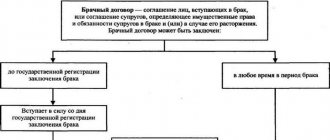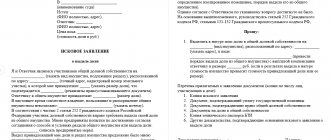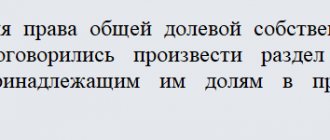Home / Housing disputes / How to calculate shares in an apartment - Online calculator
Housing in common shared ownership is registered to several owners. They may be relatives to each other or be strangers - it is not so important. It is much more important to calculate the shares in the apartment based on the total living area and the number of living co-owners. This calculation will allow you to avoid legal, everyday, personal and other disputes about the apartment.
There are three options for calculating shares in common law:
- conclude an agreement and reach an amicable agreement;
- allocate your part from the common property;
- take advantage of the judicial section of the area.
It is advisable to seek compromises and not bring the matter to trial. It is very useful to use an online calculator or calculation formula. You will learn about all the subtleties with fractions, fractions and square meters from our article.
How are shares in an apartment calculated?
According to the norms of current legislation, at the initiative of any of the co-owners of a residential premises, the procedure for allocating a new part or redistributing existing parts can begin.
There are two possible scenarios:
- residents reach an agreement through negotiations and begin the procedure;
- Some of the owners are against it and the alienation is carried out in court.
Do not confuse the concepts of section and allotment. To make it easier to understand the differences between them, check out the table below:
| Procedure | Peculiarities |
| Chapter | Housing in shared ownership is divided into several parts, each of which becomes the private property of a specific tenant |
| Allocation | After separating a small part of it from the common property, the rest of the territory retains its previous status |
How are shares in an apartment calculated?
Before you start calculating shares, you need to establish the total area of the living space - in square meters. Based on this indicator, apartments can be divided into parts in proportion to the number of co-owners.
What conditions affect the calculation:
- Number of co-sharers - the more applicants for a share in the apartment, the smaller the size of square meters for each of them.
- Joint property is not divided into parts at all, because belongs to two or more people on a common basis.
- According to paragraph 1 of Art. 245 of the Civil Code of the Russian Federation, shares are considered equal by default - the balance can be changed with the help of an agreement.
- Separation from shared ownership is allowed - through allotment in kind, i.e. creation of a separate room with a separate entrance, communications, etc.
- A one-room apartment is divided into shares, but they cannot be presented in the form of separate living rooms - the layout does not allow it.
- Co-owners can establish both equal and unequal shares - in accordance with their preferences.
- If the footage of the room does not correspond to the declared share, the co-owner pays or receives compensation from other owners.
From the general share or residential?
Usually the calculation is not related to the living area, but to the total area of the living space. However, you need to know the differences:
Residential share - presented in the form of a separate room (for example, one of the owners of a 2-room apartment has a bedroom of 15 m²).
Common is a part of housing, consisting of residential and non-residential space, which belongs to a person.
The first step is to find out the total share of a particular owner. Then imagine it as a living space - a room. Common square meters can be a corridor, a storage room, a bathroom, a toilet, a balcony - the objects are divided equally between all co-owners.
Agreement on determining shares
Family or friendly ties between owners can help with calculating shares in an apartment. The owners enter into an agreement to determine the size of shares - read about what it is and how to draw it up in our article.
The agreement assumes a peaceful solution to the issue. It is not at all necessary to follow the principle of equality - you can set arbitrary fractions depending on people's needs. One will get a spacious hall, another will get a bedroom, and the third will have a living room with a balcony. In a word, an agreement is possible and even necessary. Otherwise, litigation cannot be avoided.
If the apartment is communal
A special procedure for using a communal apartment is housing with isolated rooms and a common space. Non-residential premises in the form of a kitchen, corridor and bathroom are used by all residents, and specific rooms are used in strict accordance with the allocated share in common law (Article 42 of the Housing Code of the Russian Federation).
The family owns one, two, three or more rooms. Owners can dispose of such living space without regard to the opinions of other residents of the communal apartment.
The calculation of the share is related to the determination of square meters of isolated premises + part of the common property of the apartment (non-residential premises).
If maternity capital was used
Buying out a share in an apartment for maternity capital involves allocating percentages to children and husband . The size of future shares will have to be calculated in advance or within 6 months after the purchase and sale of housing. Read more in the article “Allocating a share to children when using maternal capital.”
Spouses can enter into an agreement and calculate the shares at their own discretion. For example, keep ⅔ for yourself, and allocate ⅓ of the fraction for your children. Calculations are related to the minimum living space per person. However, this approach is not always appropriate - if the purchased part is small, then it will not be possible to comply with the requirements.
Determination of shares in a privatized apartment
The need to determine shares in a privatized apartment arises for a number of reasons:
- divorce between spouses, which entails further division of jointly acquired property;
- inheritance of living space by several heirs;
- the presence of joint privatization;
- other special cases.
Issues of determining the share of real estate often become the cause of disputes between owners.
Some difficulties may arise if there are minor children, as well as the possibility of eviction, the impossibility of allocating a share in kind, the desire of one of the parties to sell their own share, and more.
Appeal to judicial authorities
Disputes between the parties and the impossibility of resolving the problem peacefully constitute grounds for going to court.
If a claim is filed by an owner who wishes to allocate his share of the total cost, the judge decides to allocate the share in kind or pay monetary compensation.
It is provided in cases where allocation in kind is simply impossible or when the owner’s share is insignificant.
When going to court, you need to prepare a statement of claim, which indicates the conditions of the applicant and describes in detail the controversial situation that has arisen.
Important!
The claim contains all the information about the owners (passport details, contacts) and about the residential premises.
In addition, copies of the documents required in a particular case (birth certificates, as well as passports, registration certificates, extracts from the Unified State Register, etc.) must be attached.
You can determine the share by knowing the area of the apartment and the number of owners.
Moreover, it is necessary to be guided by the rule according to which the shares of co-owners are recognized as equal, unless otherwise specified in the legislation or in the agreement of the participants in the common property.
For example, the calculation of the share of each of 3 citizens in common shared ownership in the form of an apartment with an area of 110 m² is carried out as follows:
110/3=36.7 m² - share for each of the 3 owners.
But the calculation of shares is carried out only theoretically.
In practice, when allocating the owner's real share in kind, problems may arise, since the apartment consists of premises of different sizes (bathroom, kitchen, living area, as well as loggias).
Let's take another example of how to determine the share in a privatized apartment with a total area of 71 m2, in which the rooms have an area of 20, 15, 10 m2, respectively, and the living area is 28 m2:
- For a room of 10 m2, the calculation procedure is as follows: the total area must be divided by the area of the room = 0.14 / 100 of the total area.
- For a room of 15 square meters = 21/100.
- For a room of 20 m2 = 0.28.
The share of all living space according to the same scheme will be 0.36.
How to determine shares in common shared ownership in 2021
Owning real estate involves having rights to housing and land. Apartment owners can also own land located under an apartment building, as well as other property directly related to the apartment complex.
In order to have a complete understanding of the scope of rights each homeowner has, it is necessary to study how to determine shares in common shared ownership.
Information about the scope of property rights is important for management, making important decisions, and bearing responsibility for the proper condition of common property and the entire complex of apartment buildings.
What is the owner’s share in the common property of the apartment building
Since it is possible to calculate a share in an apartment building only after identifying the full scope of the right, the very concept of common property of an apartment building requires preliminary study. According to the Code of the Russian Federation, the owners of premises in apartment buildings jointly own the following objects:
- non-residential premises;
- internal spaces that are not within the boundaries of specific apartments, related to the maintenance of premises in the house;
- areas within 1 house, adapted and equipped to fulfill social and domestic purposes in the interests of all owners;
- roofs of the building, as well as the structure of the house (load-bearing and non-load-bearing elements);
- sanitary, electrical, mechanical equipment aimed at meeting the needs of the residents of the house or any of the owners in the apartment building;
- the land on which the building stands, including areas with landscaping, landscaped, designed for operation and maintenance of the house.
By purchasing an apartment, the owner actually receives the right to a part of the entire property complex, including common premises, land, and equipment. Naturally, such property, like living space, also needs maintenance, maintenance, and improvement. To resolve legal issues related to management, it is necessary to understand the question of how to calculate the owner’s share in an apartment building.
How to calculate the share in common shared ownership
The calculation of the share in the common property of an apartment building is based on the provisions of housing legislation (Part 1, Article 37 of the Housing Code of the Russian Federation). This article establishes equal rights for property owners according to the amount of personal property. The more area a person owns, the higher the size of the share in the common property.
In simple words, the size of the common property owned by the home owner is determined in proportion to its part to the entire area of the apartment building. The calculation of shared ownership is based on the assumption that the total of all parts in the house is 100% or one. Further calculations can be carried out as a percentage (for example, 10%) or in simple fractions (for example, 1/10).
To determine the scope of the right of one of the owners, the area in the property is divided by the summarized indicator of the areas of the common property of the apartment building. There are some nuances to counting using different formulas.
Formulas used
A single formula used to identify the share of 1 owner is based on identifying the area of the apartment, the size of the owner’s property (if only part of the property is owned), and the sum of areas classified and accounted for in the category of common property.
Calculations in the form of a formula can be represented as follows:
- Share in common property = Share in the apartment x area in the apartment / sum of common areas.
When determining the scope of joint property rights for owners of communal apartments, the areas of the kitchen, bathroom, corridors, and other common areas for residents of a particular apartment are taken into account.
How to determine the amount of compensation?
In order to determine the amount of compensation, you need to calculate using a formula or an online calculator the amount of the share due to you by law. And then order an assessment of the market value of your home.
Eg. By law, you can claim 30 square meters, but in fact, taking into account the living space and the area of public facilities, you need 40. The cost of 1 square meter is 35,000 rubles. As a result, the amount of compensation in your case will be 350,000 rubles.
Agreement on determining shares
The easiest way to determine the size of each share is by concluding a peace agreement between all co-owners. In order to distribute living meters among themselves, they need, having learned the size of the total area, to decide who will get what part of it.
If at least one owner was absent when signing the agreement, the document will not have legal force. It will need to be renegotiated or acted through the courts. In order not to make mistakes in calculations, use a special online calculator.
Apartment share tax
You can determine the amount of property tax on the share allocated in kind by knowing the following indicators:
- footage of an immovable residential property;
- the current basic tax rate;
- cadastral or inventory price of the object.
Calculation example. Let's assume the following basic tax rate applies in your region:
- housing cost up to 300 tr. – 0.1% of the cadastral price;
- from 301 to 500 tr. – 0.2% of the cadastral price;
- 501 t.r. and above – 0.5% of the price.
The cost of all housing is 800 rubles. You own 1/3 of the area.
Let's start with the calculations:
- 800,000/3 = 267,000 (rubles) – the cost of your share;
- 267,000*0.5% = 1,335 (rubles) – the amount of property tax.
The formula for calculating shares is quite simple, but sometimes complex calculations are required. For example, the object is very large and many people live there, each of whom, by agreement, is assigned a room, and they are all of different sizes.
How to calculate the share in an apartment: formula
The calculation formula looks like this:
X=Y/Z + B/Z
In this case:
- X is a specific part of one person.
- Y – size of living space.
- B – size of non-residential area.
- Z – number of owners.
In this case, it is assumed that each owner will receive an equal share.
Example : The total housing area is 100 sq.m. Of these, 80 sq.m. are residential, and 20 sq.m. are non-residential. There are 2 owners. The share of each of them in square meters will be: X=80/2+20/2=50 sq.m. They will include 40 sq.m. residential and 10 sq.m. non-residential area.
Section stages
If the parties were unable to reach an agreement on how to fairly divide the housing, taking into account the interests of each co-owner, the operation can only be carried out through the court.
When making a request to allocate an independent share, keep in mind that this is not always possible to do in kind. Very rarely, the number of meters due to a tenant is equal to the size of one room. This issue is usually resolved by paying monetary compensation in favor of the remaining owners. We have already talked about how to forcibly buy out a share in an apartment, as well as how to recognize part of a property as insignificant.
How to calculate shares in an apartment in fractions
Let's assume that the total area of a two-room apartment is 50 square meters. Of them:
- Living: 40 sq.m. (One room is 25 sq.m., the other is 15 sq.m.).
- Non-residential: 10 sq.m.
In total, if you take the entire apartment equal to 1, then the residential part will be 0.8 (or 8/10), and the non-residential part will be 0.2 (or 2/10). Now we divide the living rooms. Out of 8/10, the large room takes 5/10, and the small one 3/10.
Since both owners want to own a separate living space, it is quite logical that one will have more and the other will have less. It will be possible to divide it differently only after redevelopment, if it is even available in this case. We will not consider this option. In total, in the end, one owner will receive 5/10 of the residential property for use, and the second – 3/10. But common, non-residential premises are also subject to division. In this case, everyone will receive 1/10. In total, owner No. 1 will have 5/10+1/10=6/10. And owner No. 2 will have 3/10+1/10=4/10.
Regardless of how exactly the common non-residential area was distributed, both owners have the right to unlimited use of it. However, the option of concluding an agreement on who, when and at what time has the right to use specific premises is often practiced. Example : An agreement may include a ban on taking a smartphone, laptop or books into the bathroom or toilet in order to avoid staying there for a long time. A ban on cooking certain, particularly odorous dishes can also be used (for example, you can’t fry fish at home). And often the refrigerator is also divided. For example, the top shelf belongs to one owner, and the bottom to another.










